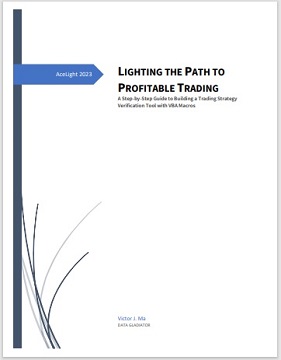The Art of Risk: Mastering Advanced Trading Strategies
|
|
Advanced stock trading strategies are like a Rubik's cube - you think you
have all the colors lined up and then suddenly everything falls apart. But
don't worry, unlike a Rubik's cube, advanced trading strategies won't leave
you feeling frustrated and confused for hours on end... just minutes! So, if
you have a high tolerance for risk, a love for adrenaline, and a stockpile
of antacids, then advanced trading strategies might just be the perfect fit
for you. Just remember, the only thing standing between you and financial
freedom is a little thing called the stock market - easy, right?
Advanced trading strategies are a set of methods and techniques used by
experienced traders to make profitable trades in financial markets. These
strategies typically involve sophisticated analysis of market data,
including technical indicators, historical price patterns, and news events.
Advanced trading strategies often require extensive knowledge of financial
markets and trading tools, as well as the ability to interpret complex data
and make quick decisions based on it.
Some examples of advanced
trading strategies include:
1. Algorithmic trading: This involves
using computer programs to automatically execute trades based on pre-defined
rules and algorithms.
2. Options trading: This involves using options
contracts to make bets on the direction of price movements in financial
markets.
3. Swing trading: This involves holding positions for several
days or weeks, taking advantage of short-term fluctuations in prices.
4.
High-frequency trading: This involves using algorithms to make trades in
fractions of a second, taking advantage of small price movements.
5.
Scalping: This involves making quick trades to take advantage of small price
movements, often within a few seconds or minutes.
Let’s take a look
at another example. Pairs trading is an advanced trading strategy that
involves simultaneously buying and selling two related securities in the
same market, with the goal of making a profit from the difference in price
between them. For example, if you believe that two stocks in the same
industry have similar valuations, but one is currently undervalued compared
to the other, you could buy the undervalued stock and sell the overvalued
stock at the same time. The idea is that as the prices of the two securities
converge over time, you will make a profit from the difference in price
between them.
To implement this strategy, you would typically need to
perform a detailed analysis of the two securities to identify a relationship
or correlation between them. You would then need to monitor the prices of
the two securities closely and make trades quickly as the prices diverge or
converge. This strategy requires a high level of skill and experience, as
well as access to advanced trading tools and technology that can help you
execute trades quickly and efficiently.
Some variations of pairs
trading strategy involve using options contracts or other derivatives to
hedge against potential losses, or using multiple securities in a single
trade to increase the potential profits. Overall, pairs trading is just one
example of an advanced trading strategy, and there are many other strategies
that traders can use to make profitable trades in financial markets,
depending on their skills, experience, and risk tolerance.
The
opposite of advanced trading strategies would be simple or basic trading
strategies. These are typically used by beginner traders who are just
starting to learn about financial markets and trading. Basic trading
strategies involve making trades based on simple analysis of market data,
such as price trends and basic technical indicators. These strategies are
generally easier to understand and implement than advanced strategies and
can be a good starting point for novice traders. Some examples of basic
trading strategies include buy-and-hold, trend following, and mean reversion
strategies. Unlike advanced trading strategies, basic trading strategies are
less complex and may not require extensive knowledge of financial markets or
advanced trading tools.
Whether advanced trading strategies are
better than simple ones depends on several factors, such as the trader's
goals, risk tolerance, and level of experience.
Advanced trading
strategies can be more complex and sophisticated, allowing traders to
potentially make larger profits or manage risks more effectively. These
strategies may involve in-depth analysis of market data, the use of advanced
trading tools and technologies, and a deep understanding of financial
markets and trading.
However, advanced trading strategies can also be
more risky and require a higher level of expertise to implement
successfully. They may require traders to invest significant time and
resources into research and analysis, as well as access to specialized
trading platforms and technologies.
On the other hand, simple trading
strategies may be easier to understand and implement for novice traders, and
may require less time and resources to execute. These strategies may involve
making trades based on simple technical or fundamental analysis of market
data, without the need for advanced tools or technologies.
In
general, the choice between advanced and simple trading strategies depends
on the individual trader's goals, risk tolerance, and level of expertise.
Some traders may find that advanced strategies are more effective for
achieving their goals, while others may prefer to stick to simpler
strategies that are easier to implement and understand.
Advanced
trading strategies are typically used by experienced traders and
institutional investors who have a deep understanding of financial markets
and trading, and are comfortable with taking on higher levels of risk in
pursuit of potentially larger profits.
Professional traders who work
for investment banks, hedge funds, or other financial institutions often use
advanced trading strategies as part of their job. These traders typically
have access to advanced trading tools and technologies, as well as extensive
training and resources to help them execute these strategies effectively.
Individual traders who are looking to use advanced trading strategies
should have a strong understanding of financial markets and trading, as well
as access to advanced trading tools and technologies. They should also be
prepared to invest significant time and resources into researching and
analyzing market data, and be comfortable taking on higher levels of risk in
pursuit of potential profits.
It's important to note that advanced
trading strategies are not suitable for everyone, and can involve
significant risk. Before using any advanced trading strategies, traders
should carefully consider their financial goals and risk tolerance, and seek
advice from a professional financial advisor if necessary.
 No
matter how advanced or simple a stock trading strategy may be, it should not
be used in real markets before it has been thoroughly tested, including both
back-testing and forward-testing. These testing methods are critical for
evaluating the effectiveness of a trading strategy and identifying potential
flaws or weaknesses before putting capital at risk in live trading. By using
these testing methods, traders can gain valuable insights into the
performance of their strategies and make adjustments as needed to optimize
their results. In short, testing is a necessary step in the development and
implementation of any successful trading strategy, regardless of its
complexity.For more details, click on
LIGHTING THE PATH TO PROFITABLE TRADING: A Step-by-Step Guide to Building a Trading Strategy Verification Tool with VBA Macros to get the whole tutorial handbook for free! No
matter how advanced or simple a stock trading strategy may be, it should not
be used in real markets before it has been thoroughly tested, including both
back-testing and forward-testing. These testing methods are critical for
evaluating the effectiveness of a trading strategy and identifying potential
flaws or weaknesses before putting capital at risk in live trading. By using
these testing methods, traders can gain valuable insights into the
performance of their strategies and make adjustments as needed to optimize
their results. In short, testing is a necessary step in the development and
implementation of any successful trading strategy, regardless of its
complexity.For more details, click on
LIGHTING THE PATH TO PROFITABLE TRADING: A Step-by-Step Guide to Building a Trading Strategy Verification Tool with VBA Macros to get the whole tutorial handbook for free!
And click Free Trial to download strategies testing tools, all for a 30-day Free Trial.
Click on Subscription to order more strategies testing tools to help your stock trading.
So there you have it, folks! Advanced trading strategies: for those
who love living on the edge, and don't mind losing a few hairs (or stocks)
in the process. Whether you're a seasoned pro or just starting out, remember
to always keep your eyes on the prize... or at least on your computer
screen. Remember the wise words of Warren Buffett: “Risk comes from not
knowing what you're doing.” So go forth, trade smart, and may the odds be
ever in your favor... or, at the very least, slightly in your favor.
|


|

Free Tutorial
Share
|
|
|
|